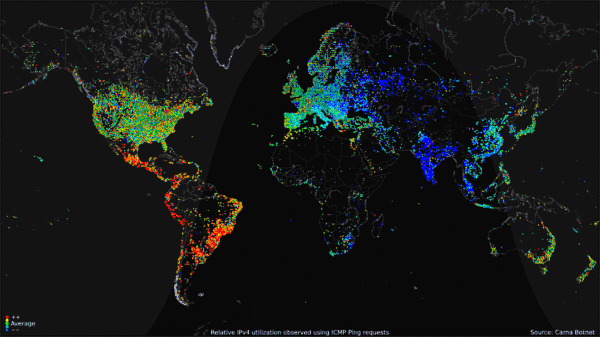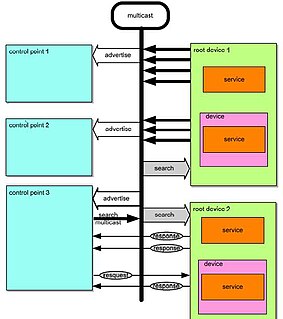
The Carna botnet was a botnet of 420,000 devices created by an anonymous hacker to measure the extent of the Internet in what the creator called the “Internet Census of 2012”.

The Carna botnet was a botnet of 420,000 devices created by an anonymous hacker to measure the extent of the Internet in what the creator called the “Internet Census of 2012”.
The data was collected by infiltrating Internet devices, especially routers, that used a default password or no password at all. [1] [2] It was named after Carna, "the Roman goddess for the protection of inner organs and health". [3]
Collected data was compiled into a GIF portrait to display Internet use around the world over the course of 24 hours. The data gathered included only the IPv4 address space and not the IPv6 address space. [4] [5]
The Carna Botnet creator believes that with a growing number of IPv6 hosts on the Internet, 2012 may have been the last time a census like this was possible. [3]
Of the 4.3 billion possible IPv4 addresses, Carna Botnet found a total of 1.3 billion addresses in use, including 141 million that were behind a firewall and 729 million that returned reverse domain name system records. The remaining 2.3 billion IPv4 addresses are probably not used. [6]
An earlier first Internet census by the USDHS LANDER-study had counted 187 million visible Internet hosts in 2006. [7] [8]
The data provided by the Carna botnet was used by security researcher Morgan Marquis-Boire to determine how many countries FinFisher spyware was being used. The use of such legally-gray data to conduct open source analysis raised questions for some, but Marquis-Boire expressed a belief that data is data. "I consider this more like rogue academia rather than criminal activity," he told Wired Magazine. [9]
Amongst other, Carna Botnet counted the number of hosts with reverse DNS names observed from May to October 2012. The top 20 Top Level Domains were:
| Number of hosts [10] | Top Level Domain |
|---|---|
| 374,670,873 | .net |
| 199,029,228 | .com |
| 75,612,578 | .jp |
| 28,059,515 | .it |
| 28,026,059 | .br |
| 21,415,524 | .de |
| 20,552,228 | .cn |
| 17,450,093 | .fr |
| 17,363,363 | .au |
| 17,296,801 | .ru |
| 16,910,153 | .mx |
| 14,416,783 | .pl |
| 14,409,280 | .nl |
| 13,702,339 | .edu |
| 11,915,681 | .ar |
| 9,157,824 | .ca |
| 8,937,159 | .uk |
| 7,452,888 | .se |
| 7,243,480 | .tr |
| 6,878,625 | .in |

Malware is any software intentionally designed to cause disruption to a computer, server, client, or computer network, leak private information, gain unauthorized access to information or systems, deprive users access to information or which unknowingly interferes with the user's computer security and privacy. By contrast, software that causes harm due to some deficiency is typically described as a software bug. Malware poses serious problems to individuals and businesses on the Internet. According to Symantec’s 2018 Internet Security Threat Report (ISTR), malware variants number has increased to 669,947,865 in 2017, which is twice as many malware variants as in 2016. Cybercrime, which includes malware attacks as well as other crimes committed by computer, was predicted to cost the world economy $6 trillion USD in 2021, and is increasing at a rate of 15% per year.

In computing, a denial-of-service attack is a cyber-attack in which the perpetrator seeks to make a machine or network resource unavailable to its intended users by temporarily or indefinitely disrupting services of a host connected to a network. Denial of service is typically accomplished by flooding the targeted machine or resource with superfluous requests in an attempt to overload systems and prevent some or all legitimate requests from being fulfilled.
Carna may refer to:
Linux malware includes viruses, Trojans, worms and other types of malware that affect the Linux family of operating systems. Linux, Unix and other Unix-like computer operating systems are generally regarded as very well-protected against, but not immune to, computer viruses.

A botnet is a group of Internet-connected devices, each of which runs one or more bots. Botnets can be used to perform Distributed Denial-of-Service (DDoS) attacks, steal data, send spam, and allow the attacker to access the device and its connection. The owner can control the botnet using command and control (C&C) software. The word "botnet" is a portmanteau of the words "robot" and "network". The term is usually used with a negative or malicious connotation.

Internet security is a branch of computer security. It encompasses the Internet, browser security, web site security, and network security as it applies to other applications or operating systems as a whole. Its objective is to establish rules and measures to use against attacks over the Internet. The Internet is an inherently insecure channel for information exchange, with high risk of intrusion or fraud, such as phishing, online viruses, trojans, ransomware and worms.

Internet Gateway Device (IGD) Standardized Device Control Protocol is a protocol for mapping ports in network address translation (NAT) setups, supported by some NAT-enabled routers. It is a common communications protocol for automatically configuring port forwarding, and is part of an ISO/IEC Standard rather than an Internet Engineering Task Force standard.
Shadowserver Foundation is a nonprofit security organization that gathers and analyzes data on malicious Internet activity, sends daily network reports to subscribers, and works with law enforcement organizations around the world in cybercrime investigations. Established in 2004 as a "volunteer watchdog group," it liaises with national governments, CSIRTs, network providers, academic institutions, financial institutions, Fortune 500 companies, and end users to improve Internet security, enhance product capability, advance research, and dismantle criminal infrastructure.
Man-in-the-browser, a form of Internet threat related to man-in-the-middle (MITM), is a proxy Trojan horse that infects a web browser by taking advantage of vulnerabilities in browser security to modify web pages, modify transaction content or insert additional transactions, all in a covert fashion invisible to both the user and host web application. A MitB attack will be successful irrespective of whether security mechanisms such as SSL/PKI and/or two- or three-factor authentication solutions are in place. A MitB attack may be countered by using out-of-band transaction verification, although SMS verification can be defeated by man-in-the-mobile (MitMo) malware infection on the mobile phone. Trojans may be detected and removed by antivirus software; this approach scored a 23% success rate against Zeus in 2009 and still low rates in a 2011 report. The 2011 report concluded that additional measures on top of antivirus software were needed.
Sality is the classification for a family of malicious software (malware), which infects files on Microsoft Windows systems. Sality was first discovered in 2003 and has advanced over the years to become a dynamic, enduring and full-featured form of malicious code. Systems infected with Sality may communicate over a peer-to-peer (P2P) network to form a botnet for the purpose of relaying spam, proxying of communications, exfiltrating sensitive data, compromising web servers and/or coordinating distributed computing tasks for the purpose of processing intensive tasks. Since 2010, certain variants of Sality have also incorporated the use of rootkit functions as part of an ongoing evolution of the malware family. Because of its continued development and capabilities, Sality is considered to be one of the most complex and formidable forms of malware to date.
Global Internet Usage is the number of people who use the Internet worldwide.
Cyber-collection refers to the use of cyber-warfare techniques in order to conduct espionage. Cyber-collection activities typically rely on the insertion of malware into a targeted network or computer in order to scan for, collect and exfiltrate sensitive information.
The following outline is provided as an overview of and topical guide to computer security:
Zombie Zero is an attack vector where a cyber attacker utilized malware that was clandestinely embedded in new barcode readers which were manufactured overseas.
BASHLITE is malware which infects Linux systems in order to launch distributed denial-of-service attacks (DDoS). Originally it was also known under the name Bashdoor, but this term now refers to the exploit method used by the malware. It has been used to launch attacks of up to 400 Gbps.
Mirai is a malware that turns networked devices running Linux into remotely controlled bots that can be used as part of a botnet in large-scale network attacks. It primarily targets online consumer devices such as IP cameras and home routers. The Mirai botnet was first found in August 2016 by MalwareMustDie, a white hat malware research group, and has been used in some of the largest and most disruptive distributed denial of service (DDoS) attacks, including an attack on 20 September 2016 on computer security journalist Brian Krebs' web site, an attack on French web host OVH, and the October 2016 Dyn cyberattack. According to a chat log between Anna-senpai and Robert Coelho, Mirai was named after the 2011 TV anime series Mirai Nikki.

Linux.Wifatch is an open-source piece of malware which has been noted for not having been used for malicious actions, instead attempting to secure devices from other malware.

MalwareMustDie, NPO is a whitehat security research workgroup that was launched in August 2012. MalwareMustDie is a registered nonprofit organization as a medium for IT professionals and security researchers gathered to form a work flow to reduce malware infection in the internet. The group is known for their malware analysis blog. They have a list of Linux malware research and botnet analysis that they have completed. The team communicates information about malware in general and advocates for better detection for Linux malware.
Hajime is a malware which appears to be similar to the Wifatch malware in that it appears to attempt to secure devices. Hajime is also far more advanced than Mirai, according to various researchers.